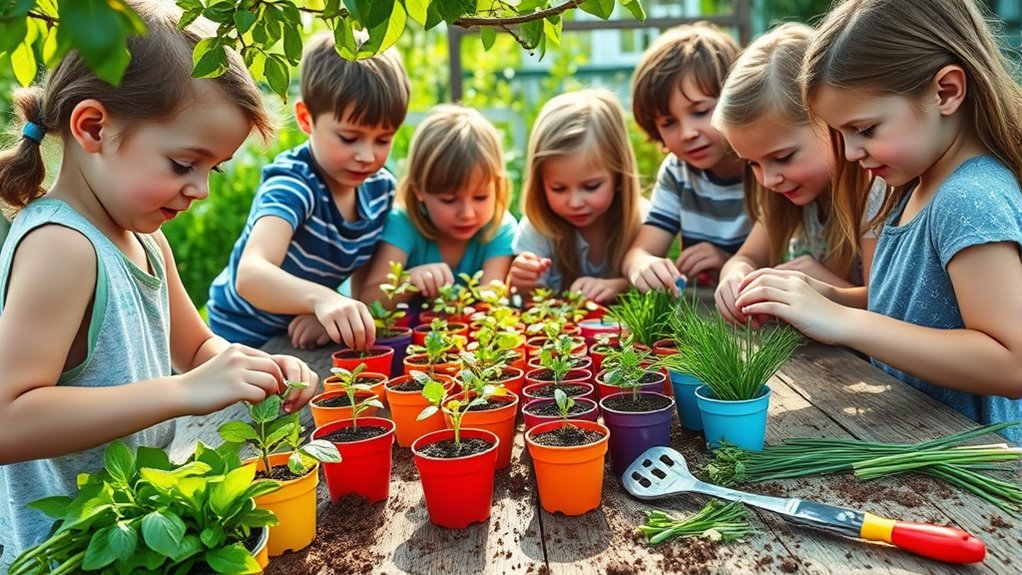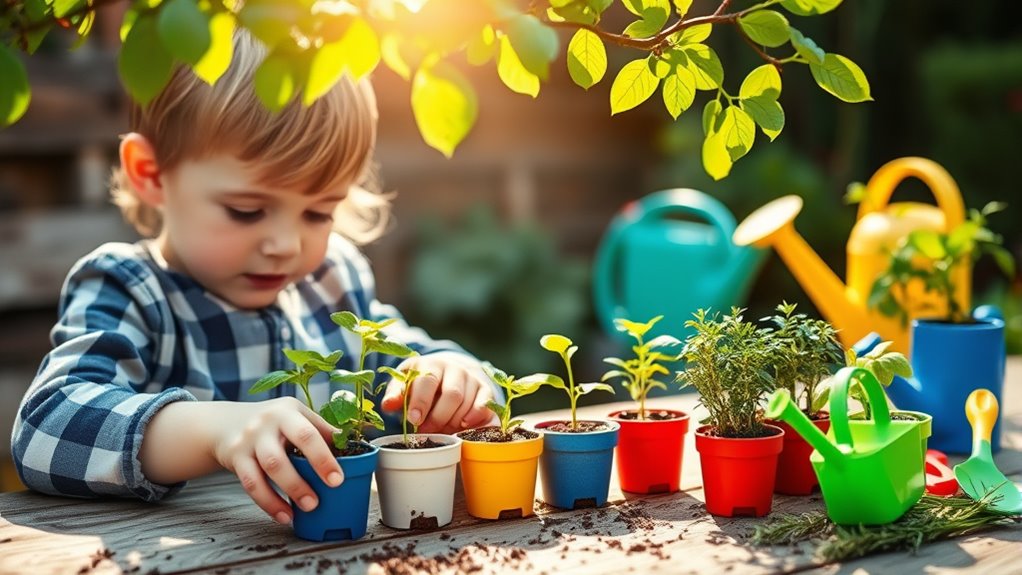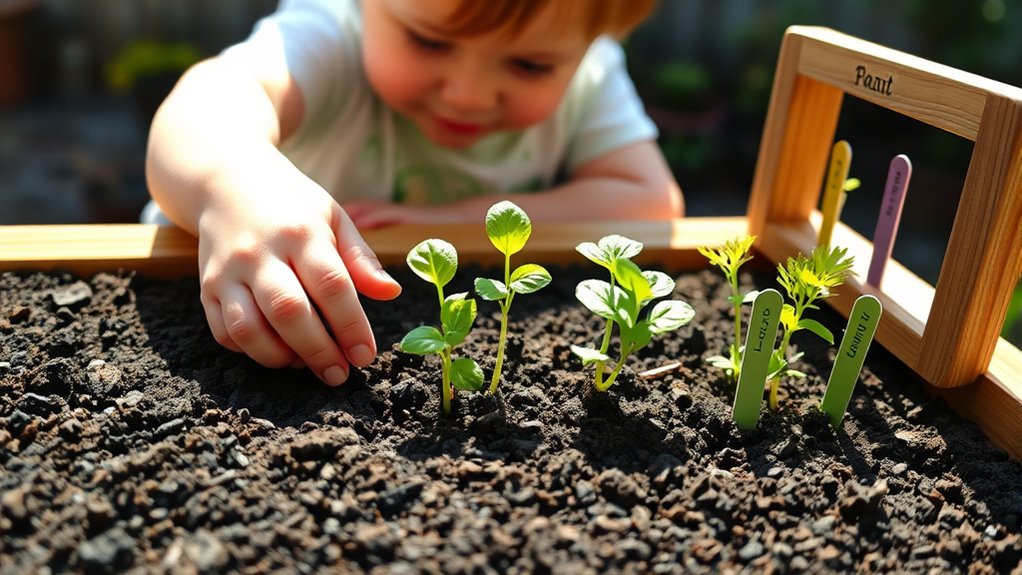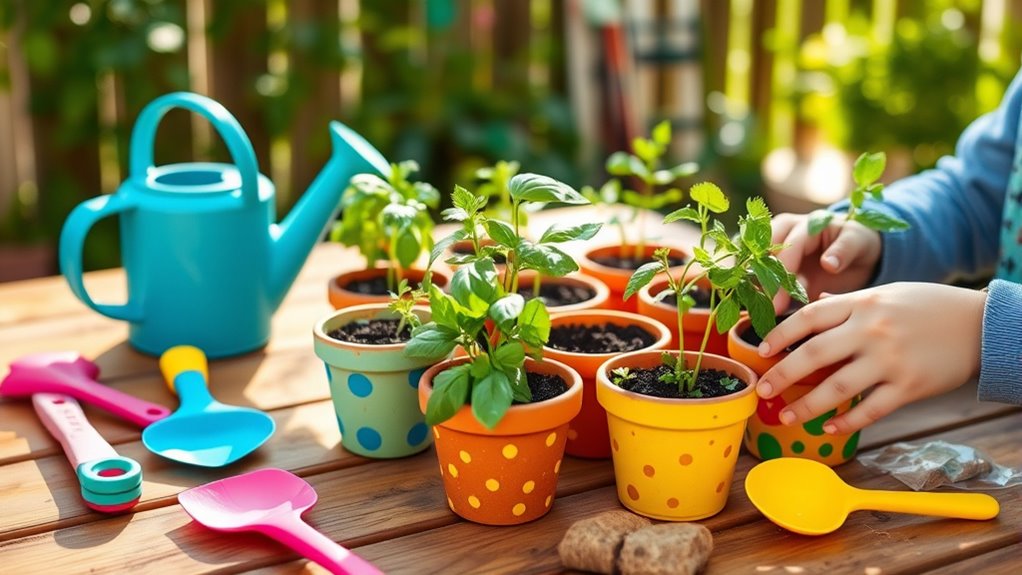Building a DIY kids’ herb garden is a fun way to teach patience and responsibility while growing flavorful herbs. Choose easy-to-grow herbs like basil or chives that are safe and simple for children to handle. Use accessible containers or beds with clear labels and set regular watering habits. Celebrate small milestones, like sprouting or leaf growth, to keep motivation high. Keep exploring for more tips on making your garden a rewarding learning experience.
Key Takeaways
- Choose easy-to-grow, mild herbs like basil or chives to keep kids engaged and avoid frustration.
- Set up accessible, colorful containers or beds to encourage hands-on participation and ownership.
- Establish a consistent watering and care routine to teach patience and responsibility through regular practice.
- Track growth milestones in a garden journal or with photos to celebrate progress and foster patience.
- Incorporate fun activities like herb labeling or garden mapping to make learning about growth and care enjoyable.
Choosing the Right Herbs for Young Gardeners

Have you ever wondered which herbs are best for kids to grow? Choosing the right herbs is essential for an enjoyable gardening experience. Start with herbs that have mild flavor profiles, like basil or chives, so kids aren’t overwhelmed by strong tastes. These herbs are easy to recognize and handle, boosting their confidence. Additionally, consider herbal medicinal uses—many herbs like chamomile or peppermint offer soothing benefits, making gardening both fun and educational. Look for herbs that are safe and simple to care for, helping kids learn responsibility without frustration. Selecting herbs with appealing flavor profiles and herbal medicinal uses encourages curiosity and a love for nature. Keep it simple, safe, and engaging to make the gardening journey enjoyable for your young gardeners. Incorporating easy-to-maintain materials can also help young gardeners succeed and build their confidence.
Setting Up Your Kid-Friendly Garden Space

Creating a kid-friendly garden space begins with choosing a safe, accessible location that invites curiosity and exploration. Opt for a spot with good sunlight and easy access, so your child can help and learn comfortably. Plan your garden layout with low, manageable beds or containers to prevent frustration and make watering simple. Incorporate natural pest prevention methods, like companion planting or protective covers, to keep pests at bay without chemicals. Keep pathways clear and wide enough for kids to move safely around the garden. Use colorful, labeled containers or markers to help your child identify herbs easily. This organized, inviting setup encourages responsibility and helps your little gardener develop patience and confidence throughout their gardening adventure. Additionally, selecting child-friendly tools designed for small hands can make the gardening process safer and more enjoyable.
Planting and Care: Teaching Responsibility and Patience

When you start planting herbs with your child, it’s a perfect opportunity to teach them about responsibility and patience. Show them how to establish regular watering routines, so the herbs stay healthy and thrive. Explain that plants need consistent care, and missing watering days can affect their growth. As the herbs grow, involve your child in pest management by checking for bugs or holes and removing pests gently. This teaches them to observe carefully and act responsibly. Encourage patience by reminding them that plants take time to grow, and rushing won’t help. Celebrate small wins, like successfully watering or spotting a pest, to build their confidence. Introducing them to plant tuning techniques can further enhance their understanding of how different herbs respond to care, fostering a deeper connection with their garden. Through this hands-on care, your child learns the importance of routine, attention, and patience in caring for living things.
Watching Growth and Celebrating Progress

As your child’s herbs begin to sprout and grow, it’s exciting to watch each small change unfold. Encourage your child to keep a garden journal, noting growth milestones like first sprout, leaf development, and height changes. This practice helps them observe progress and understand how plants develop over time. Celebrate these moments together, emphasizing that patience and consistent care lead to success. Highlighting growth milestones boosts their confidence and keeps them motivated. Take photos or draw pictures of the herbs at different stages to create a visual record of their garden journey. Recognizing progress, no matter how small, makes gardening more rewarding and teaches kids to appreciate the process of growth. Additionally, understanding industry trends can inspire new gardening ideas and techniques to try. These shared moments foster patience, curiosity, and a sense of achievement.
Tips for Making the Garden a Fun and Educational Experience

How can you make gardening both fun and educational for your kids? Start by involving them in garden design—let them choose where to plant herbs and decorate the space. This encourages ownership and excitement. Share herb history stories, like how basil was once a symbol of love or how thyme was used in ancient medicines. Incorporate simple activities, such as drawing garden maps or labeling herbs, to boost learning. Use kid-friendly tools and encourage hands-on participation to keep them engaged. Turning gardening into a story or game makes it memorable. Additionally, discussing the benefits of vertical storage solutions can help optimize space in a small garden area, making it more manageable and accessible for children. By blending garden design with herb history, you create a rich, interactive experience that teaches patience, curiosity, and the roots of culinary traditions—all while having fun.
Frequently Asked Questions
How Can I Prevent My Child From Overwatering the Herbs?
To prevent your child from overwatering the herbs, teach them about proper watering habits and moisture control. Show your child how to check soil moisture with a finger or a moisture meter before watering. Encourage watering only when the top inch of soil feels dry. Explain that consistent moisture levels help plants thrive, and overwatering can lead to root rot. With guidance, your child will develop good habits and care for the herbs properly.
What Tools Are Safest for Young Children to Use in the Garden?
Your child’s safety is a top priority, and choosing the right tools is essential. For child-safe gardening, opt for beginner gardening tools designed with rounded edges and lightweight handles—these are perfect for little hands. Look for tools made from non-toxic, durable materials that won’t break easily. With the right tools, you can turn gardening into an exciting adventure, ensuring your child learns safely and confidently in the garden—it’s like giving them a magic wand!
How Do I Handle Pests Without Harming the Kids?
You should focus on natural pest control methods that are safe for kids, like introducing beneficial insects such as ladybugs or using homemade solutions like neem oil. Avoid kid-friendly pesticides, which can still be harmful. Regularly inspect your garden for pests, and manually remove any bugs you find. This way, you protect your children while keeping pests at bay, creating a safe and healthy environment for everyone.
When Is the Best Time to Start Planting Herbs Indoors?
You should start seed starting indoors when your herbs have enough indoor sunlight, usually about 6-8 hours daily. This is ideal before the last frost date, giving your herbs a strong start. Place your seed trays near a sunny window or use grow lights if natural sunlight is limited. Starting herbs indoors now guarantees they’re healthy and ready to transplant outdoors when the weather warms up.
How Can I Encourage My Child to Stay Motivated During Slow Growth?
Did you know that kids often need about 2-3 weeks to notice real growth? To keep your child motivated, set up reward systems for reaching growth milestones, like a special treat or a fun activity. Celebrate small successes to boost their confidence. Reminding them that slow growth is normal helps develop patience and perseverance, making the process rewarding and encouraging them to stay engaged in their herb garden journey.
Conclusion
As your little gardener’s patience blossoms alongside their herbs, you’ll find joy in watching their confidence grow. With gentle guidance and a touch of encouragement, this garden becomes a quiet teacher of perseverance and care. Soon, your child will discover that even the tiniest sprout holds a world of wonder, reminding us all that growth takes time—and that patience is its most precious gift. Happy gardening, and may your shared journey flourish beautifully.








